Quantifying Long Term (2000–2020) Water Balances Across Nepal by Integrating Remote Sensing and an Ecohydrological Model
Abstract
1. Introduction
2. Materials and Methods
2.1. Study Area
2.2. Hydrological Model and Validation
2.2.1. Water Supply Stress Index Model (WaSSI) Description
2.2.2. WaSSI Model Validation
2.3. Model Input Data
2.3.1. Meteorological Data
2.3.2. Land Cover, Leaf Area Index and Soil Data
2.4. Model Validation Data
2.4.1. Observed Streamflow Data for Calculating ET and Model Validation at a Watershed Scale
2.4.2. National Remote Sensing Based ET Products
3. Results
3.1. Model Validations at Multiple Scales
3.1.1. Validating the WaSSI Model with Discharge and ET
3.1.2. Model Validation on ET Using Remote Sensing Products at Multiple Scales
3.2. Spatiotemporal Patterns of Water Balances at the National Scale
3.2.1. Spatial Distributions of Hydrological Variables
3.2.2. WaSSI Result Summary on Budyko Framework
3.2.3. Temporal Trend of Annual Water Balance
4. Discussion
4.1. Success and Uncertainty of the WaSSI Model and Remote Sensing ET Products
4.2. Implications to Water Resources Under a Changing Environment
5. Conclusions
Author Contributions
Funding
Data Availability Statement
Conflicts of Interest
References
- Bruijnzeel, L.; Sun, G.; Zhang, J.; Tiwari, K.; Hao, L. Forests, Water, and Livelihoods in the Lesser Himalaya. Eos. 2024. Available online: https://research.fs.usda.gov/treesearch/68169 (accessed on 15 May 2024).
- Xu, J.; Grumbine, R.E.; Shrestha, A.; Eriksson, M.; Yang, X.; Wang, Y.U.N.; Wilkes, A. The melting Himalayas: Cascading effects of climate change on water, biodiversity, and livelihoods. Conserv. Biol. 2009, 23, 520–530. [Google Scholar] [CrossRef] [PubMed]
- Chaulagain, N.P. Impacts of Climate Change on Water Resources of Nepal: The Physical and Socioeconomic Dimensions. Ph.D. Thesis, Flensburg University, Flensburg, Schleswig-Holstein, Germany, 2007. [Google Scholar]
- Pandit, A.; Batelaan, O.; Pandey, V.P.; Adhikari, S. Depleting spring sources in the Himalayas: Environmental drivers or just perception? J. Hydrol. Reg. Stud. 2024, 53, 101752. [Google Scholar] [CrossRef]
- Luo, Y.; Wang, L.; Hu, C.; Hao, L.; Sun, G. Changing extreme precipitation patterns in Nepal over 1971–2015. Earth Space Sci. 2024, 11, e2024EA003563. [Google Scholar] [CrossRef]
- Acharya, S.; Hori, T.; Karki, S. Assessing the spatio-temporal impact of landuse landcover change on water yield dynamics of rapidly urbanizing Kathmandu valley watershed of Nepal. J. Hydrol. Reg. Stud. 2023, 50, 101562. [Google Scholar] [CrossRef]
- Poudel, N.; Shaw, R. Challenges of Urban Water Security and Drivers of Water Scarcity in Kathmandu Valley, Nepal. Urban Sci. 2025, 9, 54. [Google Scholar] [CrossRef]
- United Nation-Habitat. Cities and Climate Action: World Cities Report 2024. Available online: https://unhabitat.org/ (accessed on 12 May 2025).
- Kulkarni, H.; Desai, J.; Siddique, M.I. Rejuvenation of springs in the Himalayan Region. In Water, Climate Change, and Sustainability, 1st ed.; Pandey, V.P., Shrestha, S., Wiberg, D., Eds.; John Wiley & Sons, Inc.: Hoboken, NJ, USA, 2021; pp. 97–107. [Google Scholar]
- Vose, J.M.; Sun, G.; Ford, C.R.; Bredemeier, M.; Otsuki, K.; Wei, X.; Zhang, Z.; Zhang, L. Forest ecohydrological research in the 21st century: What are the critical needs? Ecohydrology 2011, 4, 146–158. [Google Scholar] [CrossRef]
- Sun, G.; Tiwari, K.R.; Hao, L.; Amatya, D.; Liu, N.; Song, C. Climate change and forest hydrology in future forests. In Future Forests Mitigation and Adaptation to Climate Change; Elsevier Inc.: Amsterdam, The Netherlands, 2024; Chapter 6; pp. 95–124. [Google Scholar]
- Sun, G.; Hallema, D.; Asbjornsen, H. Ecohydrological processes and ecosystem services in the Anthropocene: A review. Ecol. Process. 2017, 6, 35. [Google Scholar] [CrossRef]
- Badu, M.; Nuberg, I.; Ghimire, C.P.; Bajracharya, R.M.; Meyer, W.S. Negative trade-offs between community forest use and hydrological benefits in the forested catchments of Nepal’s mid-hills. Mt. Res. Dev. 2019, 39, R22. [Google Scholar] [CrossRef]
- Thapa, B.R.; Ishidaira, H.; Pandey, V.P.; Shakya, N.M. A multi-model approach for analyzing water balance dynamics in Kathmandu Valley, Nepal. J. Hydrol. Reg. Stud. 2017, 9, 149–162. [Google Scholar] [CrossRef]
- Talchabhadel, R.; Chhetri, R. Evaluation of long-term changes in water balances in the Nepal Himalayas. Theor. Appl. Climatol. 2024, 155, 439–450. [Google Scholar] [CrossRef]
- Bastola, S.; Seong, Y.J.; Lee, S.H.; Jung, Y. Water yield estimation of the Bagmati basin of Nepal using GIS based InVEST model. J. Korea Water Resour. Assoc. 2019, 52, 637–645. [Google Scholar]
- Bharati, L.; Gurung, P.; Jayakody, P.; Smakhtin, V.; Bhattarai, U. The projected impact of climate change on water availability and development in the Koshi Basin, Nepal. Mt. Res. Dev. 2014, 34, 118–130. [Google Scholar] [CrossRef]
- Budhathoki, B.R.; Adhikari, T.R.; Shrestha, S.; Awasthi, R.P. Application of hydrological model to simulate streamflow contribution on water balance in Himalaya river basin, Nepal. Front. Earth Sci. 2023, 11, 1128959. [Google Scholar] [CrossRef]
- Dhami, B.; Himanshu, S.K.; Pandey, A.; Gautam, A.K. Evaluation of the SWAT model for water balance study of a mountainous snowfed river basin of Nepal. Environ. Earth Sci. 2018, 77, 21. [Google Scholar] [CrossRef]
- Baniya, B.; Tang, Q.; Adhikari, T.R.; Zhao, G.; Haile, G.G.; Sigdel, M.; He, L. Climate change induced Melamchi extreme flood and environment implication in central Himalaya of Nepal. Nat. Hazards 2024, 120, 11009–11029. [Google Scholar] [CrossRef]
- Pradhan, A.M.S.; Silwal, G.; Shrestha, S.; Huynh, T.C.; Dawadi, S. Can a Spatially Distributed Hydrological Model Effectively Analyze Hydrological Processes in the Nepal Himalaya River Basin? Environ. Model. Assess. 2024, 29, 1037–1058. [Google Scholar] [CrossRef]
- Nepal, S.; Krause, P.; Flügel, W.A.; Fink, M.; Fischer, C. Understanding the hydrological system dynamics of a glaciated alpine catchment in the Himalayan region using the J2000 hydrological model. Hydrol. Process. 2014, 28, 1329–1344. [Google Scholar] [CrossRef]
- Shrestha, S.; Nepal, S. Water balance assessment under different glacier coverage scenarios in the Hunza Basin. Water 2019, 11, 1124. [Google Scholar] [CrossRef]
- Zhang, Y.; Kong, D.; Gan, R.; Chiew, F.H.; McVicar, T.R.; Zhang, Q.; Yang, Y. Coupled estimation of 500 m and 8-day resolution global evapotranspiration and gross primary production in 2002–2017. Remote Sens. Environ. 2019, 222, 165–182. [Google Scholar] [CrossRef]
- Bhattarai, N.; Wagle, P. Recent advances in remote sensing of evapotranspiration. Remote Sens. 2021, 13, 4260. [Google Scholar] [CrossRef]
- Sun, G.; Wei, X.; Hao, L.; Sanchis, M.G.; Hou, Y.; Yousefpour, R.; Tang, R.; Zhang, Z. Forest hydrology modeling tools for watershed management: A review. For. Ecol. Manag. 2023, 530, 120755. [Google Scholar] [CrossRef]
- Zhang, J.; Kong, D.; Li, J.; Qiu, J.; Zhang, Y.; Gu, X.; Guo, M. Comparison and integration of hydrological models and machine learning models in global monthly streamflow simulation. J. Hydrol. 2025, 650, 132549. [Google Scholar] [CrossRef]
- Yi, K.; Senay, G.B.; Fisher, J.B.; Wang, L.; Suvočarev, K.; Chu, H.; Moore, G.W.; Novick, K.A.; Barnes, M.L.; Keenan, T.F.; et al. Challenges and future directions in quantifying terrestrial evapotranspiration. Water Resour. Res. 2024, 60, e2024WR037622. [Google Scholar] [CrossRef]
- Ghimire, C.P.; Bruijnzeel, L.A.; Lubczynski, M.W.; Bonell, M. Negative trade-off between changes in vegetation water use and infiltration recovery after reforesting degraded pasture land in the Nepalese Lesser Himalaya. Hydrol. Earth Syst. Sci. 2014, 18, 4933–4949. [Google Scholar] [CrossRef]
- Srinet, R.; Nandy, S.; Watham, T.; Padalia, H.; Patel, N.R.; Chauhan, P. Measuring evapotranspiration by eddy covariance method and understanding its biophysical controls in moist deciduous forest of northwest Himalayan foothills of India. Trop. Ecol. 2022, 63, 387–397. [Google Scholar] [CrossRef]
- Deb Burman, P.K.D.; Launiainen, S.; Mukherjee, S.; Chakraborty, S.; Gogoi, N.; Murkute, C.; Lohani, P.; Sarma, D.; Kumar, K. Ecosystem-atmosphere carbon and water exchanges of subtropical evergreen and deciduous forests in India. For. Ecol. Manag. 2021, 495, 119371. [Google Scholar] [CrossRef]
- Deb Burman, P.K.; Sarma, D.; Morrison, R.; Karipot, A.; Chakraborty, S. Seasonal variation of evapotranspiration and its effect on the surface energy budget closure at a tropical forest over north-east India. J. Earth Syst. Sci. 2019, 128, 127. [Google Scholar] [CrossRef]
- Dorji, U.; Olesen, J.E.; Seidenkrantz, M.S. Water balance in the complex mountainous terrain of Bhutan and linkages to land use. J. Hydrol. Reg. Stud. 2016, 7, 55–68. [Google Scholar] [CrossRef]
- Zhou, D.; Zhang, L.; Hao, L.; Sun, G.; Xiao, J.; Li, X. Large discrepancies among remote sensing indices for characterizing vegetation growth dynamics in Nepal. Agric. For. Meteorol. 2023, 339, 109546. [Google Scholar] [CrossRef]
- Long, D.; Longuevergne, L.; Scanlon, B.R. Uncertainty in evapotranspiration from land surface modeling, remote sensing, and GRACE satellites. Water Resour. Res. 2014, 50, 1131–1151. [Google Scholar] [CrossRef]
- Glenn, E.P.; Huete, A.R.; Nagler, P.L.; Hirschboeck, K.K.; Brown, P. Integrating remote sensing and ground methods to estimate evapotranspiration. Crit. Rev. Plant Sci. 2007, 26, 139–168. [Google Scholar] [CrossRef]
- Sun, G.; Caldwell, P.; Noormets, A.; McNulty, S.G.; Cohen, E.; Moore Myers, J.; Domec, J.C.; Treasure, E.; Mu, Q.; Xiao, J.; et al. Upscaling key ecosystem functions across the conterminous United States by a water-centric ecosystem model. J. Geophys. Res. Biogeosciences 2011, 116, G00J05. [Google Scholar] [CrossRef]
- Sun, G.; Alstad, K.; Chen, J.; Chen, S.; Ford, C.R.; Lin, G.; Liu, C.; Lu, N.; McNulty, S.G.; Miao, H.; et al. A general predictive model for estimating monthly ecosystem evapotranspiration. Ecohydrology 2011, 4, 245–255. [Google Scholar] [CrossRef]
- Li, Z.L.; Tang, R.; Wan, Z.; Bi, Y.; Zhou, C.; Tang, B.; Yan, G.; Zhang, X. A review of current methodologies for regional evapotranspiration estimation from remotely sensed data. Sensors 2009, 9, 3801–3853. [Google Scholar] [CrossRef]
- Zhang, K.; Kimball, J.S.; Running, S.W. A review of remote sensing based actual evapotranspiration estimation. Wiley Interdiscip. Rev. Water 2016, 3, 834–853. [Google Scholar] [CrossRef]
- Liu, M.; Bárdossy, A.; Li, J.; Jiang, Y. Physically-based modeling of topographic effects on spatial evapotranspiration and soil moisture patterns through radiation and wind. Hydrol. Earth Syst. Sci. 2012, 16, 357–373. [Google Scholar] [CrossRef]
- Yang, Y.; Anderson, M.; Gao, F.; Hain, C.; Noormets, A.; Sun, G.; Wynne, R.; Thomas, V.; Sun, L. Investigating impacts of drought and disturbance on evapotranspiration over a forested landscape in North Carolina, USA using high spatiotemporal resolution remotely sensed data. Remote Sens. Environ. 2020, 238, 111018. [Google Scholar] [CrossRef]
- Volk, J.M.; Huntington, J.L.; Melton, F.S.; Allen, R.; Anderson, M.; Fisher, J.B.; Kilic, A.; Ruhoff, A.; Senay, G.B.; Minor, B.; et al. Assessing the accuracy of OpenET satellite-based evapotranspiration data to support water resource and land management applications. Nat. Water 2024, 2, 193–205. [Google Scholar] [CrossRef]
- Gao, S.; Wang, L.; Hao, L.; Sun, G. Community forestry dominates the recent land greening amid climate change in Nepal. Environ. Res. Lett. 2023, 18, 104014. [Google Scholar] [CrossRef]
- Badu, M.; Ghimire, C.P.; Bruijnzeel, L.A.; Nuberg, I.; Meyer, W.S. Net precipitation, infiltration and overland flow production in three types of community-managed forest in the Mid-hills of East Central Nepal. Trees, Forests and People 2022, 8, 100218. [Google Scholar] [CrossRef]
- Pokhrel, G.; Rijal, M.L. Recent Trends in the Study of Springs in Nepal: A Review. Bull. Dep. Geol. 2024, 24, 47–55. [Google Scholar] [CrossRef]
- Shrestha, A.B.; Aryal, R. Climate change in Nepal and its impact on Himalayan glaciers. Reg. Environ. Change 2011, 11, 65–77. [Google Scholar] [CrossRef]
- Kansakar, S.R.; Hannah, D.M.; Gerrard, J.; Rees, G. Spatial pattern in the precipitation regime of Nepal. Int. J. Climatol. A J. R. Meteorol. Soc. 2004, 24, 1645–1659. [Google Scholar] [CrossRef]
- Caldwell, P.V.; Sun, G.; McNulty, S.G.; Cohen, E.C.; Moore Myers, J.A. Impacts of impervious cover, water withdrawals, and climate change on river flows in the conterminous U.S. Hydrol. Earth Syst. Sci. 2012, 16, 2839–2857. [Google Scholar] [CrossRef]
- Tavernia, B.G.; Nelson, M.D.; Caldwell, P.; Sun, G. Water Stress Projections for the North eastern and Midwestern United States in 2060: Anthropogenic and Ecological Consequences. J. Am. Water Resour. Assoc. (JAWRA) 2013, 49, 938–952. [Google Scholar] [CrossRef]
- Bagstad, K.J.; Cohen, E.; Ancona, Z.H.; McNulty, S.G.; Sun, G. The sensitivity of ecosystem service models to choices of input data and spatial resolution. Appl. Geogr. 2018, 93, 25–36. [Google Scholar] [CrossRef]
- Liu, N. Changes in Water and Carbon in Australian Vegetation in Response to Climate Change [Murdoch University]. 2017. Available online: https://researchrepository.murdoch.edu.au/id/eprint/40206/ (accessed on 1 October 2024).
- Liu, N.; SUN, P.-S.; Liu, S.-R.; Sun, G. Determination of spatial scale of response unit for WASSI-C eco–hydrological model—A case study on the upper Zagunao River watershed of China. Chin. J. Plant Ecol. 2013, 37, 132–141. [Google Scholar] [CrossRef]
- Lu, J.; Sun, G.; McNulty, S.G.; Amatya, D.M. A comparison of six potential evapotranspiration methods for regional use in the southeastern United States 1. JAWRA J. Am. Water Resour. Assoc. 2005, 41, 621–633. [Google Scholar] [CrossRef]
- Federer, C.A.; Lash, D. BROOK: A Hydrologic Simulation Model for Eastern Forests; N H Water Resources Research Center Scholarship.172; University of New Hampshire: Durham, NH, USA, 1978. [Google Scholar]
- Bao, W.; Chen, Y. A Conceptual Flow-Sedimentation Coupled simulation Model for Large Basins. Adv. Water Sci. 1994, 5, 287–292. (In Chinese) [Google Scholar]
- Budyko, M.I. Climate and Life; Academic Press: New York, NY, USA, 1974; p. 508. [Google Scholar]
- Fu, B.P. On the calculation of the evaporation from the land surface. Sci. Atmos. Sin. 1981, 5, 23–31. (In Chinese) [Google Scholar]
- Hamon, W.R. Estimating Potential Evapotranspiration. J. Hydraul. Div. 1961, 87, 107–120. [Google Scholar] [CrossRef]
- Yang, K.; Jiang, Y.; Tang, W.; He, J.; Shao, C.; Zhou, X.; Lu, H.; Chen, Y.; Li, X.; Shi, J. A HIGH-RESOLUTION NEAR-SURFACE METEOROLOGICAL FORCING DATASET for the Third Pole Region (TPMFD, 1979–2022). National Tibetan Plateau/Third Pole Environment Data Center. 2023. Available online: https://data.tpdc.ac.cn/en/data/44a449ce-e660-44c3-bbf2-31ef7d716ec7 (accessed on 27 March 2023).
- Jiang, Y.; Yang, K.; Qi, Y.; Zhou, X.; He, J.; Lu, H.; Li, X.; Chen, Y.; Li, X.D.; Zhou, B.; et al. TPHiPr: A long-term (1979–2020) high-accuracy precipitation dataset (1/30◦, daily) for the Third Pole region based on high-resolution atmospheric modeling and dense observations. Earth Syst. Sci. Data 2023, 15, 621–638. [Google Scholar] [CrossRef]
- Subba, S.; Ma, Y.; Ma, W.; Cun-Bo Han, C. Extreme precipitation detection ability of four high-resolution precipitation product datasets in hilly area: A case study in Nepal. Adv. Clim. Change Res. 2024, 15, 390–405. [Google Scholar] [CrossRef]
- Xiang, Y.; Zeng, C.; Zhang, F.; Wang, L. Effects of climate change on runoff in a representative Himalayan basin assessed through optimal integration of multi-source precipitation data. J. Hydrol. Reg. Stud. 2024, 53, 101828. [Google Scholar] [CrossRef]
- Xiao, Z.; Liang, S.; Wang, J.; Xiang, Y.; Zhao, X.; Song, J. Long-Time-Series Global Land Surface Satellite Leaf Area Index Product Derived From MODIS and AVHRR Surface Reflectance. IEEE Trans. Geosci. Remote Sens. 2016, 54, 5301–5318. [Google Scholar] [CrossRef]
- Liu, N. A priori global 250m parameters for the SAC-SMA model. v1. CSIRO. Data Collection. 2024. Available online: https://data.csiro.au/collection/csiro:62260 (accessed on 1 May 2024).
- Liu, N. Global 250m Soil Hydraulic Properties. v1. CSIRO. Data Collection. 2024. Available online: https://data.csiro.au/collection/csiro:62126 (accessed on 1 May 2024).
- Senay, G.B.; Bohms, S.; Singh, R.K.; Gowda, P.H.; Velpuri, N.M.; Alemu, H.; Verdin, J.P. Operational Evapotranspiration Mapping Using Remote Sensing and Weather Datasets: A New Parameterization for the SSEB Approach. J. Am. Water Resour. Assoc. 2013, 49, 577–591. [Google Scholar] [CrossRef]
- Zheng, C.; Jia, L.; Hu, G. Global land surface evapotranspiration monitoring by ETMonitor model driven by multi-source satellite earth observations. J. Hydrol. 2022, 613, 128444. [Google Scholar] [CrossRef]
- Fu, J.; Wang, W.; Shao, Q.; Xing, W.; Cao, M.; Wei, J.; Chen, Z.; Nie, W. Improved global evapotranspiration estimates using proportionality hypothesis-based water balance constraints. Remote Sens. Environ. 2022, 279, 113140. [Google Scholar] [CrossRef]
- Poncea, V.M.; Shetty, A.V. A conceptual model of catchment water balance: 1. Formulation and calibration. J. Hydrol. 1995, 173, 27–40. [Google Scholar] [CrossRef]
- Jung, M.; Koirala, S.; Weber, U.; Ichii, K.; Gans, F.; Camps-Valls, G.; Papale, D.; Schwalm, C.; Tramontana, G.; Reichstein, M. The FLUXCOM ensemble of global land-atmosphere energy fluxes. Sci. Data 2019, 6, 74. [Google Scholar] [CrossRef]
- Mann, H.B. Non-parametric test against trend. Econometrical 1945, 13, 245–259. [Google Scholar] [CrossRef]
- Kendall, M.G. Rank Correlation Methods; London Press: London, UK, 1975. [Google Scholar]
- Tian, F.; Nan, Y.; Ni, G.; Yang, L.; Tang, Q.; Grey, D. Is the Tibetan Plateau really a water tower? Hydrol. Process. 2024, 38, e15103. [Google Scholar] [CrossRef]
- Nan, Y.; Tian, F.; McDonnell, J.; Ni, G.; Tian, L.; Li, Z.; Yan, D.; Xia, X.; Wang, T.; Han, S.; et al. Glacier meltwater has limited contributions to the total runoff in the major rivers draining the Tibetan Plateau. npj Clim. Atmos. Sci. 2025, 8, 155. [Google Scholar] [CrossRef]
- Miller, J.D.; Immerzeel, W.W.; Rees, G. Climate change impacts on glacier hydrology and river discharge in the Hindu Kush–Himalayas. Mt. Res. Dev. 2012, 32, 461–467. [Google Scholar] [CrossRef]
- Valerio, F.; Godinho, S.; Ferraz, G.; Pita, R.; Gameiro, J.; Silva, B.; Marques, A.; Silva, J. Multi-temporal remote sensing of inland surface waters: A fusion of Sentinel-1&2 data applied to small seasonal ponds in semiarid environments. Int. J. Appl. Earth Obs. Geoinf. 2024, 135, 104283. [Google Scholar]
- Mengistu, M.G.; Savage, M.J. Open water evaporation estimation for a small shallow reservoir in winter using surface renewal. J. Hydrol. 2010, 380, 27–35. [Google Scholar] [CrossRef]
- Fang, Y.; Sun, G.; Caldwell, P.; McNulty, S.G.; Noormets, A.; Domec, J.C.; King, J.; Zhang, Z.; Zhang, X.; Lin, G.; et al. Monthly land cover-specific evapotranspiration models derived from global eddy flux measurements and remote sensing data. Ecohydrology 2016, 9, 248–266. [Google Scholar] [CrossRef]
- Fisher, J.B.; Tu, K.P.; Baldocchi, D.D. Global estimates of the land–atmosphere water flux based on monthly AVHRR and ISLSCP-II data, validated at 16 FLUXNET sites. Remote Sens. Environ. 2008, 112, 901–919. [Google Scholar] [CrossRef]
- Allen, R.G.; Pereira, L.S.; Raes, D.; Smith, M. Crop Evapotranspiration-Guidelines for Computing Crop Water Requirements-FAO Irrigation and Drainage Paper 56; FAO: Rome, Italy, 1998; Volume 300, p. D05109. [Google Scholar]
- Priestley, C.H.B.; Taylor, R.J. On the assessment of surface heat flux and evaporation using large-scale parameters. Mon. Weather Rev. 1972, 100, 81–92. [Google Scholar] [CrossRef]
- Tiwari, K.R.; Rayamajhi, S. Devastating monsoon: Water induced disaster management practices in Nepal. For. J. Inst. For. Nepal 2018, 15, 57–76. [Google Scholar] [CrossRef]
- Gurung, A.; Adhikari, S.; Chauhan, R.; Thakuri, S.; Nakarmi, S.; Ghale, S.; Dongol, B.S.; Rijal, D. Water crises in a water-rich country: Case studies from rural watersheds of Nepal’s mid-hills. Water Policy 2019, 21, 826–847. [Google Scholar] [CrossRef]
- Jackson, M.; Azam, M.F.; Baral, P.; Benestad, R.; Brun, F.; Muhammad, S.; Pradhananga, S.; Shrestha, F.; Steiner, J.F.; Thapa, A. Consequences of climate change for the cryosphere in the Hindu Kush Himalaya. In Water, Ice, Society, and Ecosystems in the Hindu Kush Himalaya: An Outlook; Wester, P., Chaudhary, S., Chettri, N., Jackson, M., Maharjan, A., Nepal, S., Steiner, J.F., Eds.; International Centre for Integrated Mountain Development (ICIMOD): Patan, Nepal, 2023; pp. 17–71. [Google Scholar] [CrossRef]
- Panwar, S. Vulnerability of Himalayan springs to climate change and anthropogenic impact: A review. J. Mt. Sci. 2020, 17, 117–132. [Google Scholar] [CrossRef]

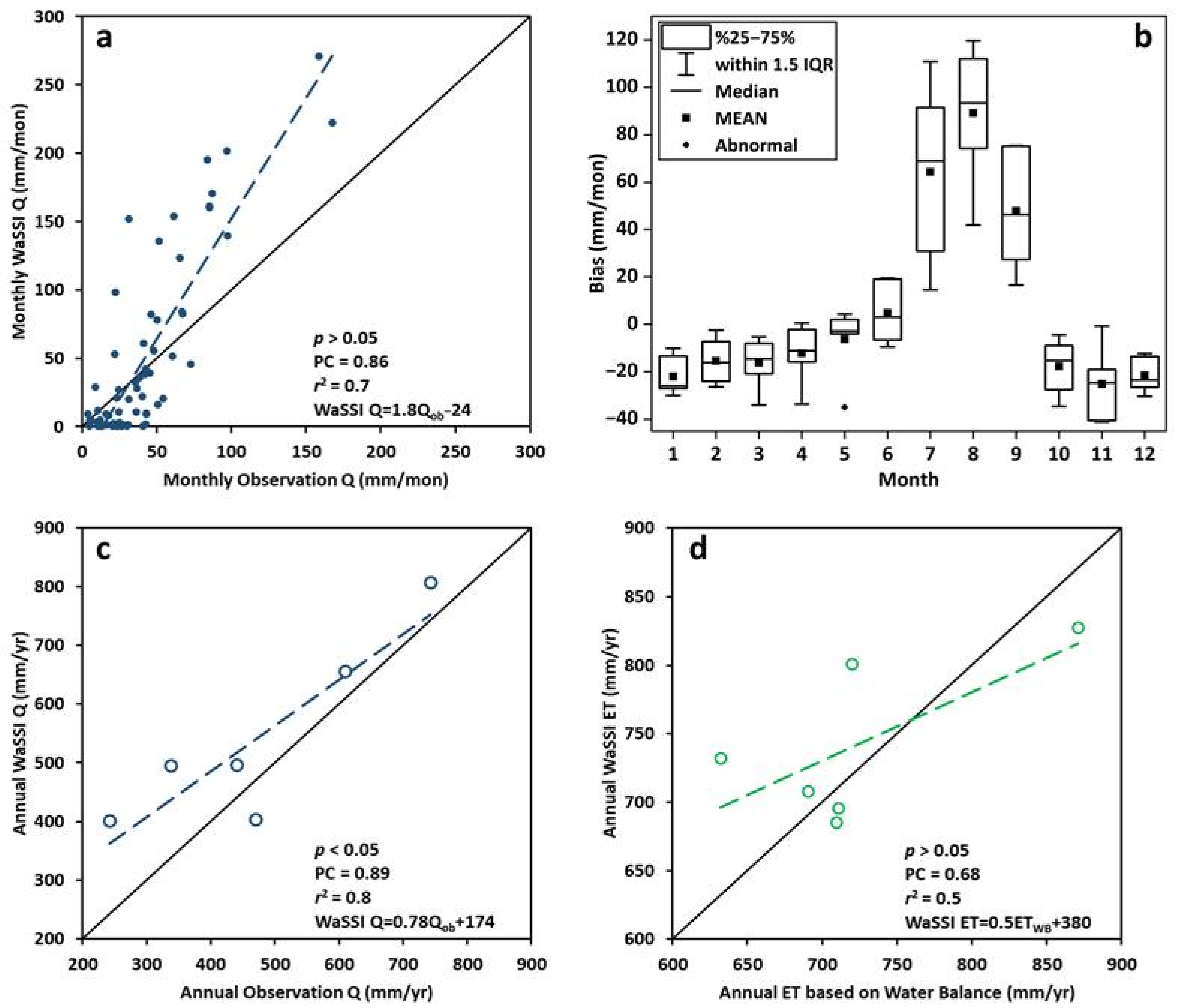

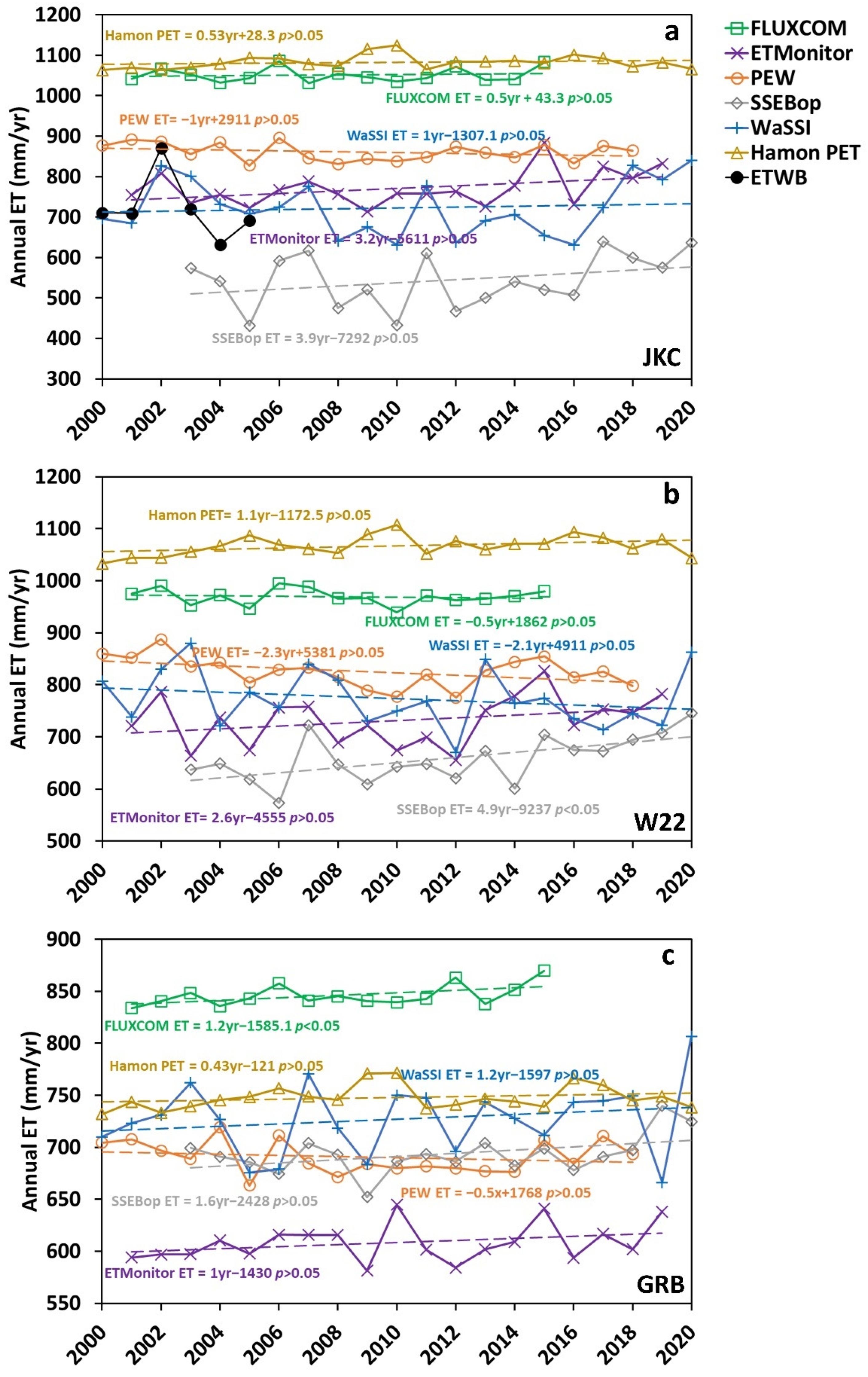
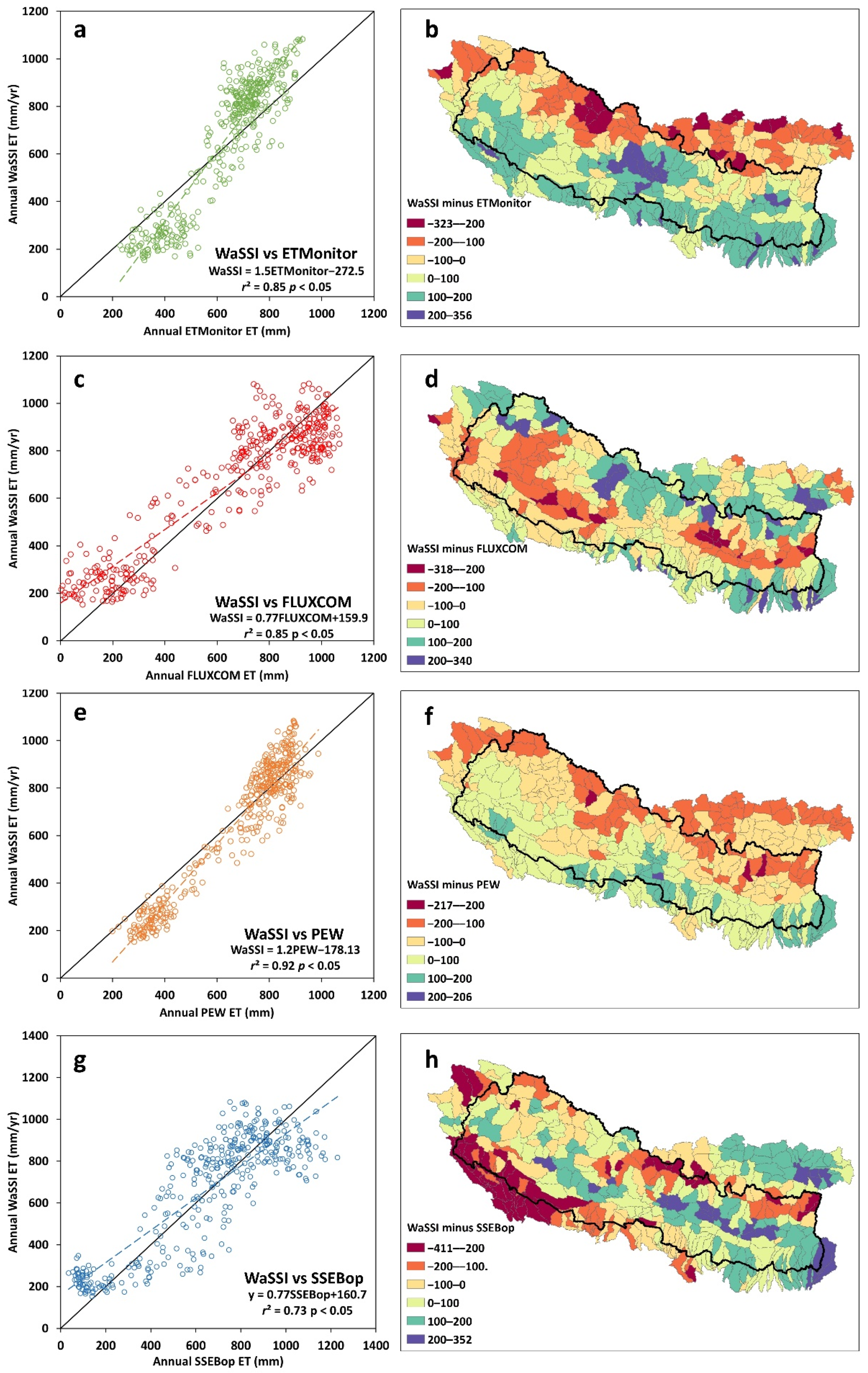
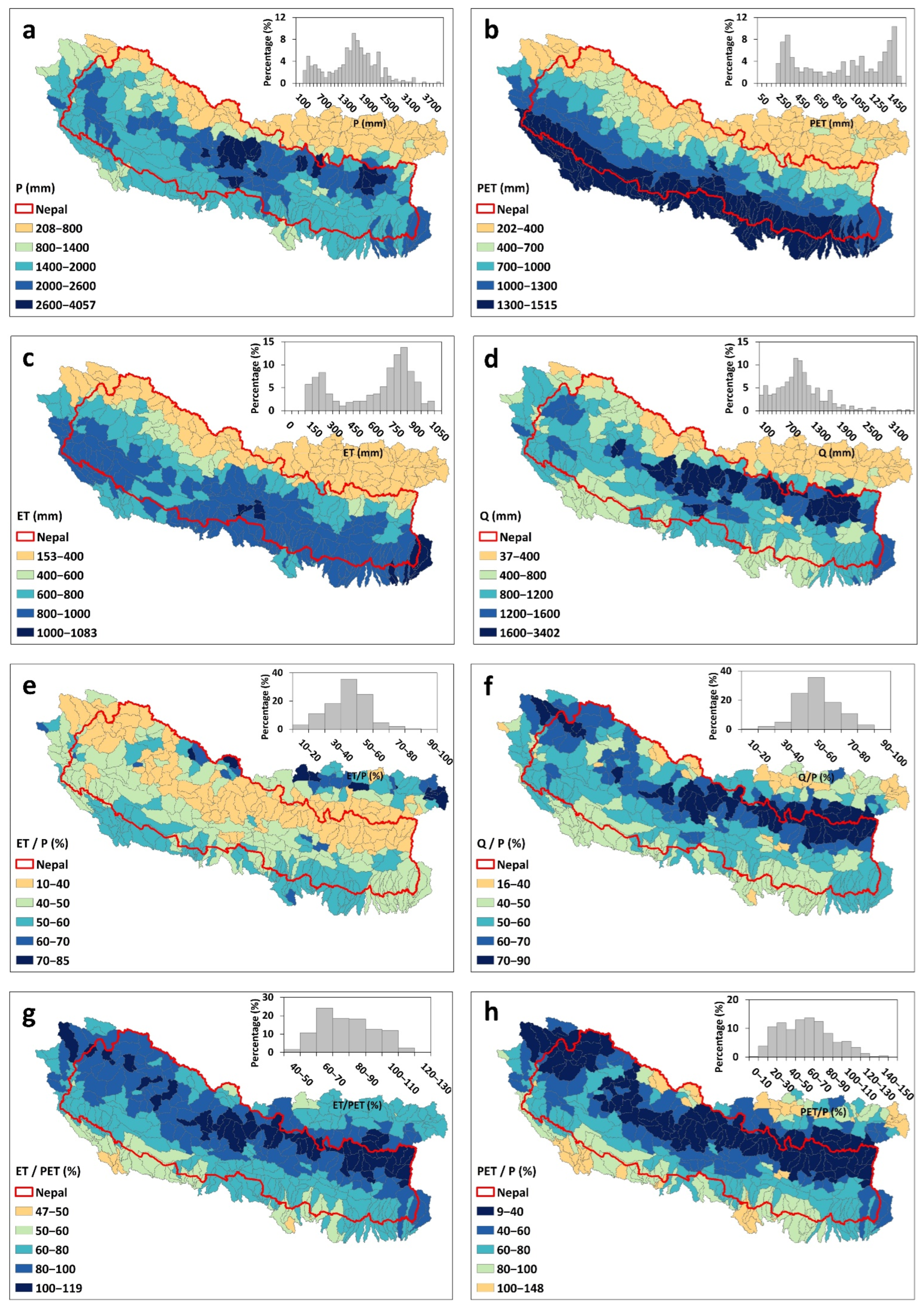

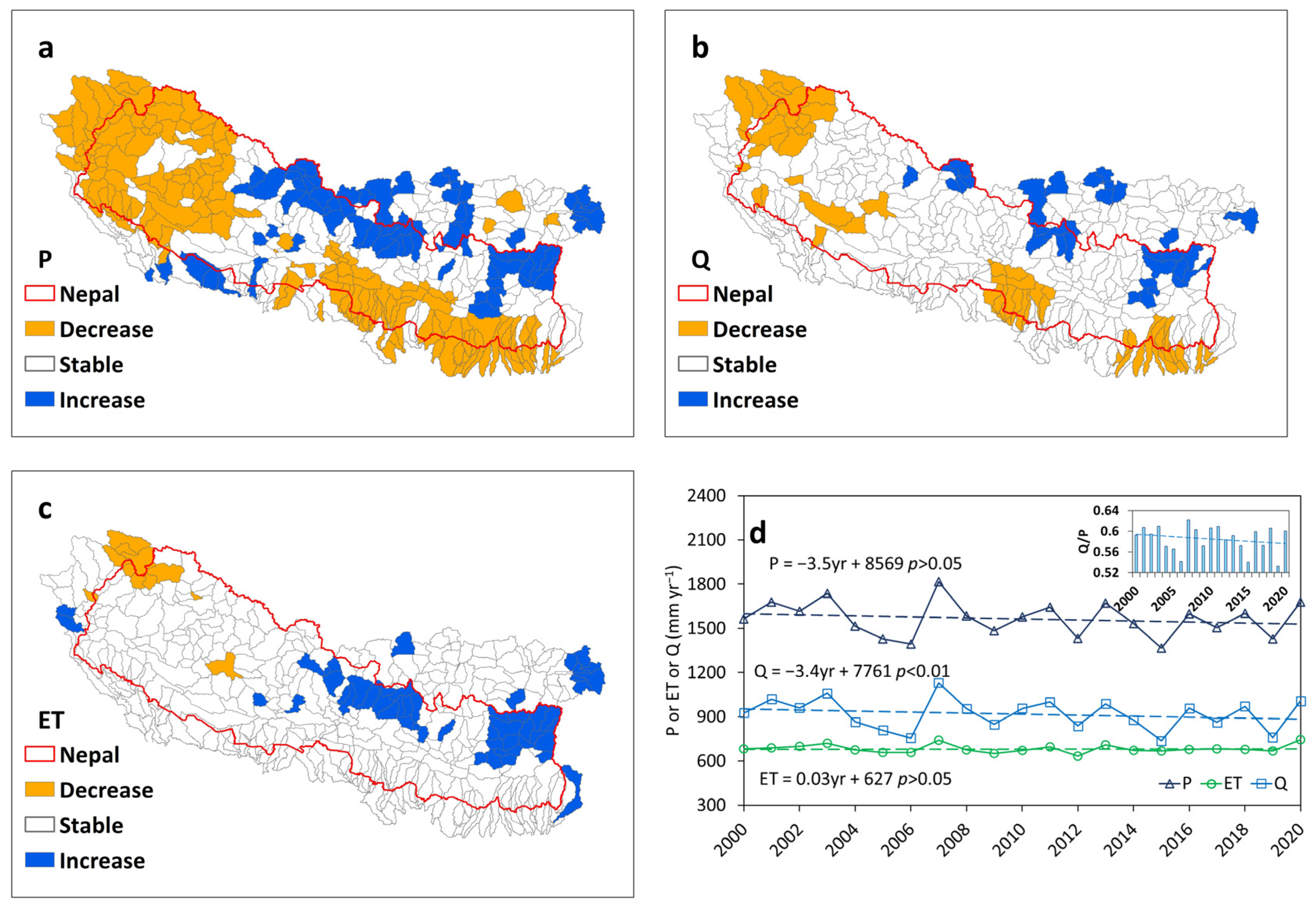
| Data | Purpose | Resolution | Time Period | Source |
|---|---|---|---|---|
| ETMonitor | ET validation | 1 km/month | 2001–2019 | https://data.tpdc.ac.cn/home (accessed on 5 September 2022) |
| FLUXCOM | ET Validation | 0.0833°/8-day | 2001–2015 | http://www.fluxcom.org/ (accessed on 12 January 2025) |
| SSEBop | ET validation | 1 km/month | 2003–2020 | https://earlywarning.usgs.gov/fews/product/458 (accessed on 7 July 2021) |
| PEW | ET validation | 0.1°/monthly | 1982–2018 | https://data.tpdc.ac.cn (accesed on 18 September 2023) |
| TPMFD | PET calculation and WaSSI model input | 0.03°/day | 1979–2020 | https://data.tpdc.ac.cn/home (accessed on 27 March 2023) |
| A priori global 250 m parameters for the SAC-SMA model | Soil parameters for WaSSI model input | 250 m | — | https://doi.org/10.25919/vj30-h988 (accessed on 1 May 2024) |
| GLASS LAI | LAI data for WaSSI model input | 500-m/8-day | 2001–2020 | http://www.glass.umd.edu/ (accessed on 8 September 2024) |
| Land cover | WaSSI modeling | 300 m/yearly | 2000–2020 | https://cds.climate.copernicus.eu/ (accessed on 5 November 2024) |
| Precipitation | Water balance validation | Station/daily | 1980–2014 | http://www.dhm.gov.np/hydrological-station/ (accessed on 5 March 2022) |
| Streamflow | Water balance validation | Station/daily | 2000–2005 | http://www.dhm.gov.np/hydrological-station/ (accessed on 5 March 2022) |
| WaSSI Q vs. Qobs | WaSSI ET vs. ETWB | WaSSI ET vs. ETMonitor | |
|---|---|---|---|
| Model bias (mm/yr) | 69.5 ± 83.4 | 19 ± 59 | −4.6 ± 23 |
| Relative Bias (%) | 14.7% | 2.6% | −7.2% |
Disclaimer/Publisher’s Note: The statements, opinions and data contained in all publications are solely those of the individual author(s) and contributor(s) and not of MDPI and/or the editor(s). MDPI and/or the editor(s) disclaim responsibility for any injury to people or property resulting from any ideas, methods, instructions or products referred to in the content. |
© 2025 by the authors. Licensee MDPI, Basel, Switzerland. This article is an open access article distributed under the terms and conditions of the Creative Commons Attribution (CC BY) license (https://creativecommons.org/licenses/by/4.0/).
Share and Cite
Jin, K.; Liu, N.; Tang, R.; Sun, G.; Hao, L. Quantifying Long Term (2000–2020) Water Balances Across Nepal by Integrating Remote Sensing and an Ecohydrological Model. Remote Sens. 2025, 17, 1819. https://doi.org/10.3390/rs17111819
Jin K, Liu N, Tang R, Sun G, Hao L. Quantifying Long Term (2000–2020) Water Balances Across Nepal by Integrating Remote Sensing and an Ecohydrological Model. Remote Sensing. 2025; 17(11):1819. https://doi.org/10.3390/rs17111819
Chicago/Turabian StyleJin, Kailun, Ning Liu, Run Tang, Ge Sun, and Lu Hao. 2025. "Quantifying Long Term (2000–2020) Water Balances Across Nepal by Integrating Remote Sensing and an Ecohydrological Model" Remote Sensing 17, no. 11: 1819. https://doi.org/10.3390/rs17111819
APA StyleJin, K., Liu, N., Tang, R., Sun, G., & Hao, L. (2025). Quantifying Long Term (2000–2020) Water Balances Across Nepal by Integrating Remote Sensing and an Ecohydrological Model. Remote Sensing, 17(11), 1819. https://doi.org/10.3390/rs17111819







